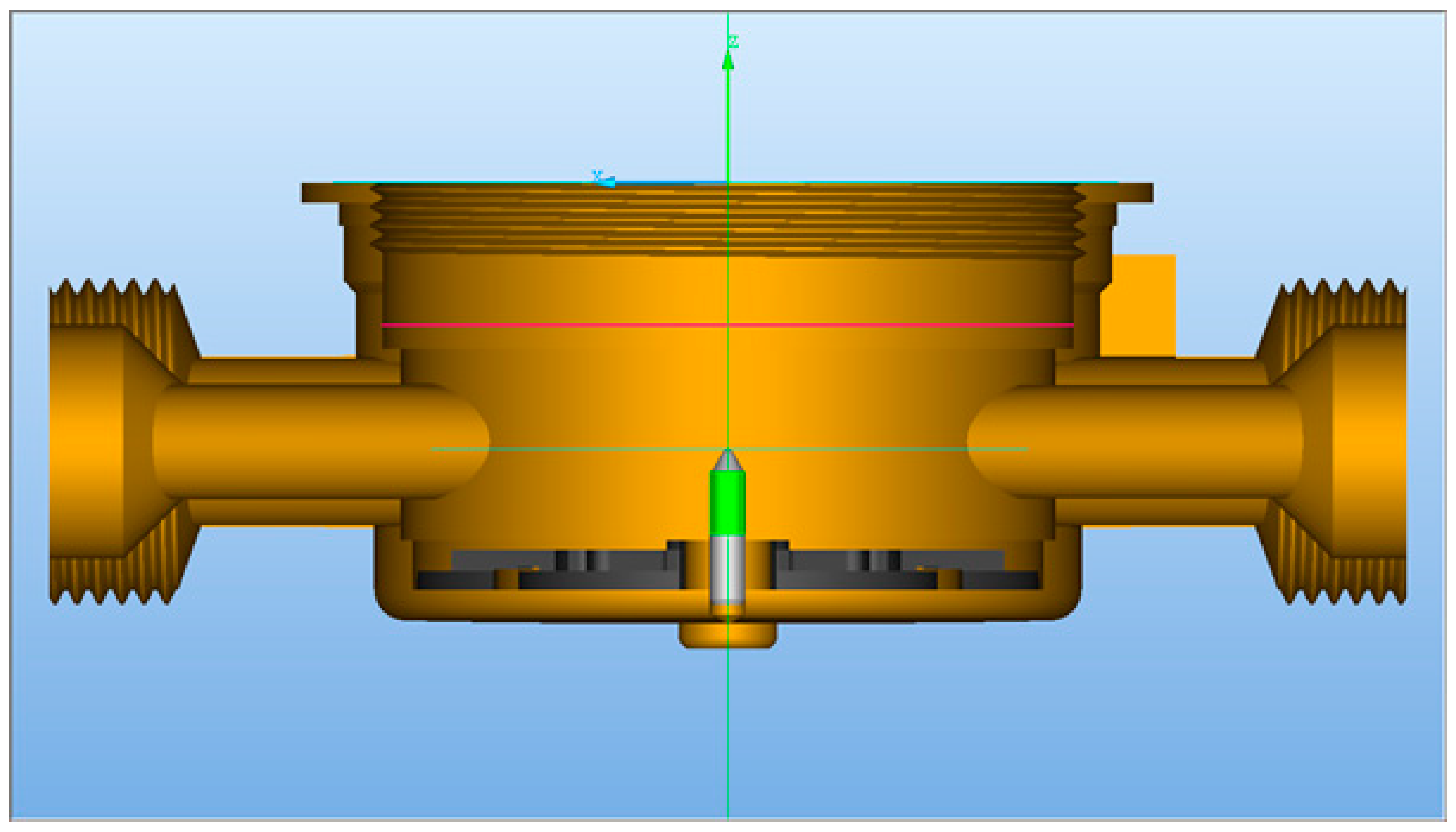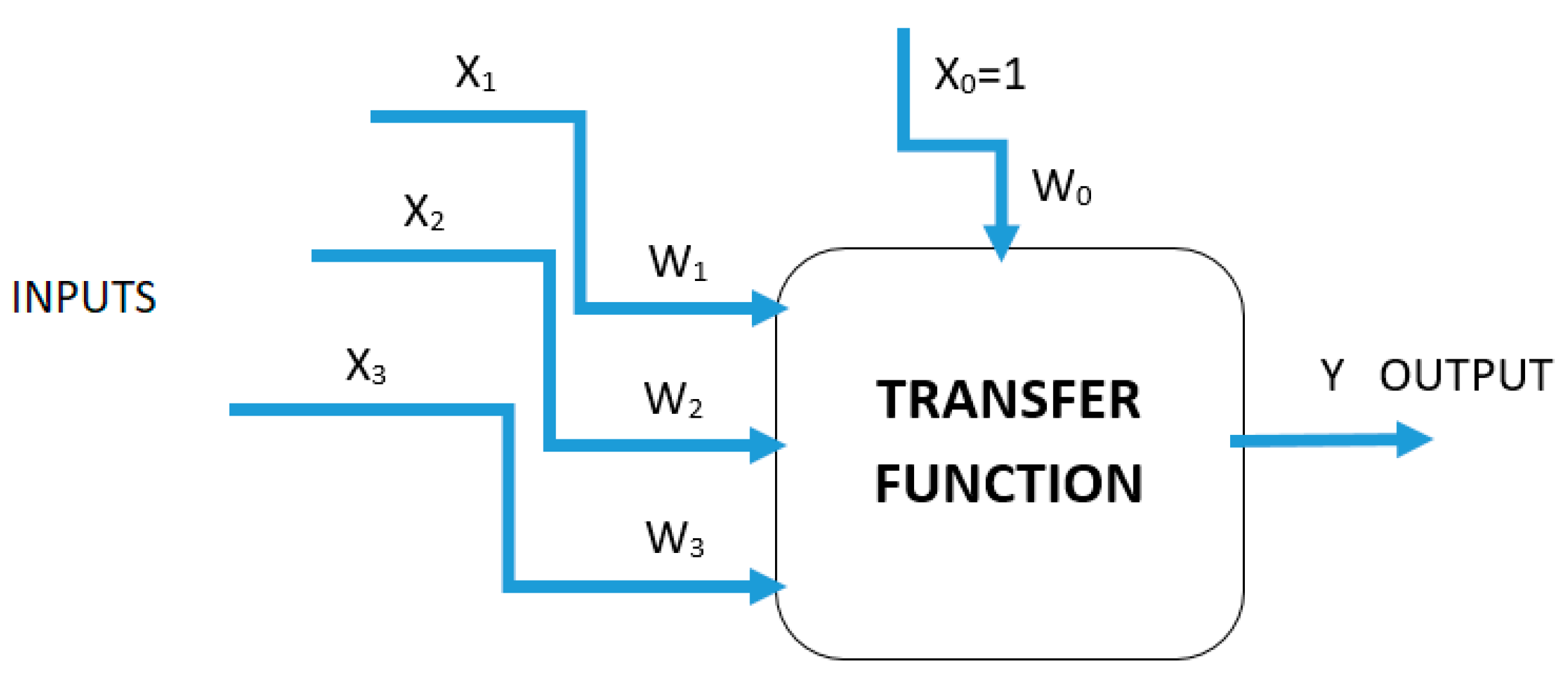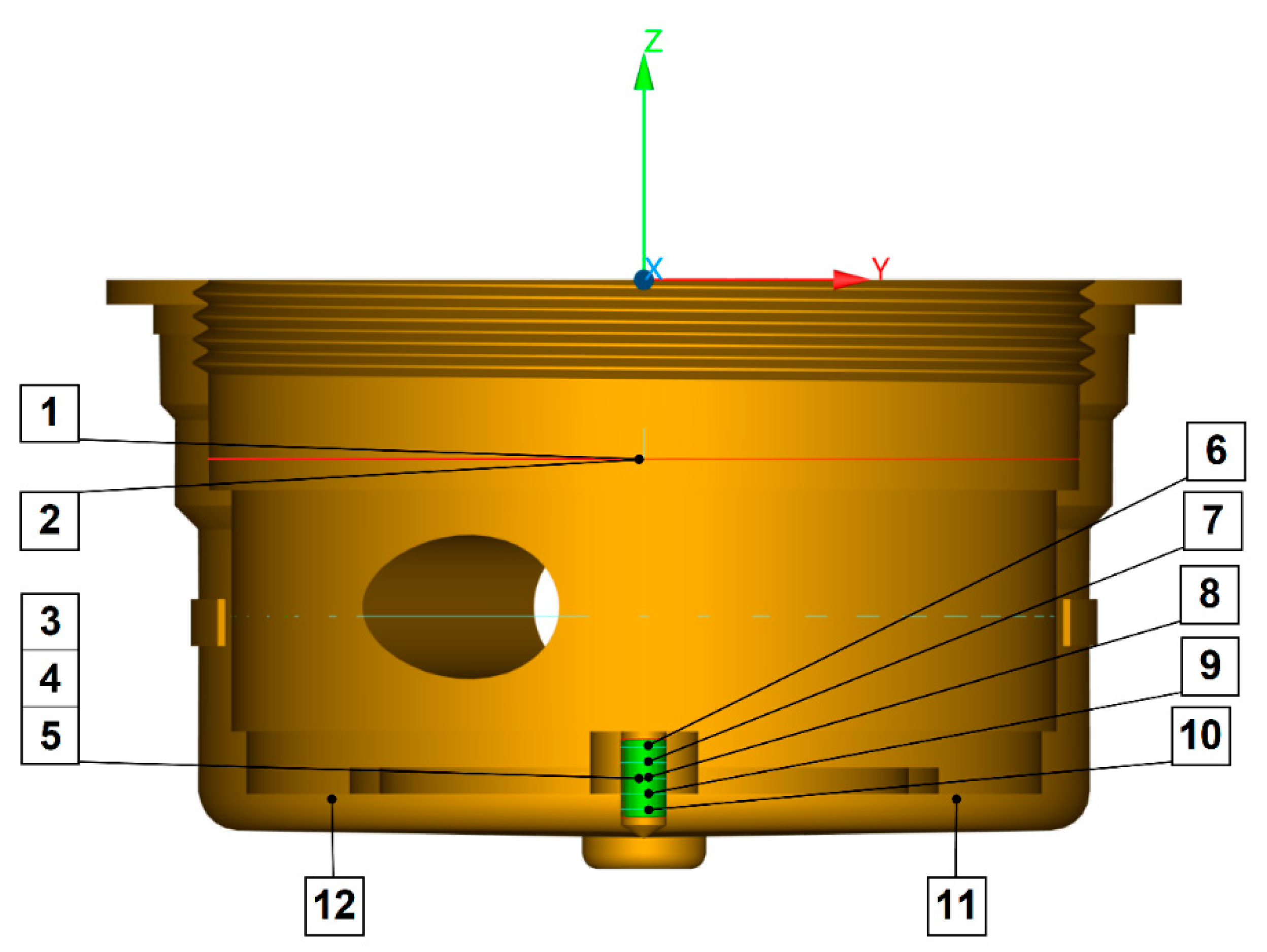Application of Neural Networks for Water Meter Body Assembly Process Optimization
Abstract
:1. Introduction
2. Materials and Methods
2.1. Artificial Neural Networks in Mechanical Assembly Problem
2.2. The Concept of a System Supporting the Optimization of Radial Runout in the Assembly Process Based on Artificial Neutral Networks
- The value of the clamping force for the first and second assembly steps;
- Number of cycles performed by presser (it is possible to replace it);
- Time of applied force in the second assembly operation;
- The type of used clamp;
- Sequence of assembly procedures.
- The dimension of the main reference diameter;
- The roundness deviation of the main reference diameter;
- The dimension of the hole for the axle that is being assembled (averaged);
- The dimension in five planes of the hole for the axle that is being assembled, along its entire depth;
- The position of the hole for axle that is being assembled relative to the main reference diameter in the X axis;
- The position of the hole for axle that is being assembled relative to the main reference diameter in the Y axis;
- The body bottom wall thickness on the left and right sides of the symmetry axis;
- The average thickness of the body bottom.
2.3. Assumptions of a Neural Network
3. Results
Parameters and Operation of the Modeled Neural Network
- Network type (MLP—multilayer perceptron, RBF—radial basis functions network);
- Number of hidden neurons (integers in the range from 1 up to and including 30);
- Hidden and output neurons activation function—applies only to MLP (linear, logistic, hyperbolic tangent, exponential, sine).
- The number of data conditioning the prediction task (18 inputs and 1 output);
- The type of prediction algorithm of the modeled output variable (regression algorithm for one variable assuming continuous values);
- Data categorization (quantified, defined numerically);
- Percentage share of data in groups performing the task of learning (70%), testing (15%) and validating the neural network (15%).
4. Conclusions
Author Contributions
Funding
Institutional Review Board Statement
Informed Consent Statement
Conflicts of Interest
References
- Qi, X.; Chen, G.; Li, Y.; Cheng, X.; Li, C. Applying Neural-Network-Based Machine Learning to Additive Manufacturing: Current Applications, Challenges, and Future Perspectives. Engineering 2019, 5, 721–729. [Google Scholar] [CrossRef]
- Scime, L.; Beuth, J. A multi-scale convolutional neural network for autonomous anomaly detection and classification in a laser powder bed fusion additive manufacturing process. Addit. Manuf. 2018, 24, 273–286. [Google Scholar] [CrossRef]
- Mundada, V.; Narala, S.K.R. Optimization of Milling Operations Using Artificial Neural Networks (ANN) and Simulated Annealing Algorithm (SAA). Mater. Today Proc. 2018, 5, 4971–4985. [Google Scholar] [CrossRef]
- Pfrommer, J.; Zimmerling, C.; Liu, J.; Kärger, L.; Henning, F.; Beyerer, J. Optimisation of manufacturing process parameters using deep neural networks as surrogate models. Procedia CIRP 2018, 72, 426–431. [Google Scholar] [CrossRef]
- Wojciechowski, J.; Suszyński, M.; Żurek, J.; Vjesnik, T. No Clamp Robotic Assembly with Use of Point Cloud Data from Low-Cost Triangulation Scanner. Teh. Vjesn. 2018, 25, 904–909. [Google Scholar]
- Iwańkowicz, R. Optimization of assembly plan for large offshore structures. Adv. Sci. Technol. Res. J. 2012, 6, 31–36. [Google Scholar] [CrossRef]
- Ciszak, O.; Suszyński, M. Selection of Assembly Sequence for Manual Assembly Based on DFA Rating Factors. In Advances in Manufacturing II. Volume 2-Production Engineering and Management; Springer: Midtown Manhattan, NY, USA, 2019. [Google Scholar]
- Chen, S.-F.; Liu, Y.-J. An adaptive genetic assembly-sequence planner. Int. J. Comput. Integr. Manuf. 2001, 14, 489–500. [Google Scholar] [CrossRef]
- Wang, D.; Shao, X.; Liu, S. Assembly sequence planning for reflector panels based on genetic algorithm and ant colony optimization. Int. J. Adv. Manuf. Technol. 2017, 91, 987–997. [Google Scholar] [CrossRef]
- Xin, L.; Jianzhong, S.; Yujun, C. An efficient method of automatic assembly sequence planning for aerospace industry based on genetic algorithm. Int. J. Adv. Manuf. Technol. 2017, 90, 1307–1315. [Google Scholar] [CrossRef]
- Sinanoglu, C.; Börklü, H.R. An assembly sequence-planning system for mechanical parts using neural network. Assem. Autom. 2005, 25, 38–52. [Google Scholar] [CrossRef]
- Suszyński, M.; Peta, K. Assembly Sequence Planning Using Artificial Neural Networks for Mechanical Parts Based on Selected Criteria. Appl. Sci. 2021, 11, 10414. [Google Scholar] [CrossRef]
- Suszyński, M.; Peta, K.; Černohlávek, V.; Svoboda, M. Mechanical Assembly Sequence Determination Using Artificial Neural Networks Based on Selected DFA Rating Factors. Symmetry 2022, 14, 1013. [Google Scholar] [CrossRef]
- Chen, W.-C.; Tai, P.-H.; Deng, W.-J.; Hsieha, L.-F. A three-stage integrated approach for assembly sequence planning using neural networks. Expert Syst. Appl. 2008, 34, 1777–1786. [Google Scholar] [CrossRef]
- Kucukoglu, I.; Atici-Ulusua, H.; Gunduz, T.; Tokcalar, O. Application of the artificial neural network method to detect defective assembling processes by using a wearable technology. J. Manuf. Syst. 2018, 49, 163–171. [Google Scholar] [CrossRef]
- Židek, K.; Hosovsky, A.; Piteľ, J.; Bednár, S. Recognition of Assembly Parts by Convolutional Neural Networks. In Advances in Manufacturing Engineering and Materials; Springer: Cham, Switzerland, 2018; pp. 281–289. [Google Scholar]
- Patel, A.; Andrews, P.; Summers, J.D.; Harrison, E.; Schulte, J.; Mears, M.L. Evaluating the Use of Artificial Neural Networks and Graph Complexity to Predict Automotive Assembly Quality Defects. J. Comput. Inf. Sci. Eng. 2017. [Google Scholar] [CrossRef]
- Tadeusiewicz, R.; Chaki, R.; Chaki, N. Exploring Neural Networks with C#; CRC Press: Boca Raton, FL, USA, 2015. [Google Scholar]
- Lu, Z.; Jiang, J.; Cao, P.; Yang, Y. Assembly Quality Detection Based on Class-Imbalanced Semi-Supervised Learning. Appl. Sci. 2021, 11, 10373. [Google Scholar] [CrossRef]
- Jiang, J.; Cao, P.; Lu, Z.; Lou, W.; Yang, Y. Surface Defect Detection for Mobile Phone Back Glass Based on Symmetric Convolutional Neural Network Deep Learning. Appl. Sci. 2020, 10, 3621. [Google Scholar] [CrossRef]
- Zhan, G.; Wang, W.; Sun, H.; Hou, Y.; Feng, L. Auto-CSC: A Transfer Learning Based Automatic Cell Segmentation and Count Framework. Cyborg Bionic Syst. 2022, 2022, 9842349. [Google Scholar] [CrossRef] [PubMed]
- Bai, D.; Liu, T.; Han, X.; Yi, H. Application Research on Optimization Algorithm of sEMG Gesture Recognition Based on Light CNN + LSTM Model. Cyborg Bionic Syst. 2021, 2021, 9794610. [Google Scholar] [CrossRef] [PubMed]
- Iwańkowicz, R.; Taraska, M. Self-classification of assembly database using evolutionary method. Assem. Autom. 2018, 38, 268–281. [Google Scholar] [CrossRef]
- Broomhead, D.S.; Lowe, D. Radial Basis Functions, Multi-Variable Functional Interpolation and Adaptive Networks; Report, Royal Signals and Radar Establishment: Malvern, PA, USA, 1988. [Google Scholar]





| Network ID | Network Name | Quality (tRaining) | Quality (Testing) | Quality (Validation) | Error (Training) | Error (Testing) | Error (Validation) | Activation (Hidden) | Activation (Output) | Number of Epochs |
| 1 | MLP 18-19-1 | 0.921 | 0.919 | 0.928 | 0.006 | 0.007 | 0.007 | Tanh | Tanh | 47 |
| 2 | MLP 18-12-1 | 0.924 | 0.921 | 0.918 | 0.006 | 0.007 | 0.007 | Tanh | Sine | 33 |
| 3 | MLP 18-8-1 | 0.906 | 0.907 | 0.908 | 0.006 | 0.007 | 0.007 | Logistic | Tanh | 8 |
| 4 | MLP 18-27-1 | 0.902 | 0.899 | 0.913 | 0.006 | 0.008 | 0.007 | Tanh | Exponential | 45 |
| 5 | MLP 18-20-1 | 0.911 | 0.924 | 0.929 | 0.006 | 0.007 | 0.007 | Tanh | Tanh | 138 |
| 6 | MLP 18-7-1 | 0.906 | 0.901 | 0.916 | 0.006 | 0.007 | 0.007 | Logistic | Logistic | 478 |
| 7 | MLP 18-3-1 | 0.913 | 0.893 | 0.931 | 0.006 | 0.007 | 0.007 | Logistic | Linear | 123 |
| 8 | MLP 18-16-1 | 0.894 | 0.891 | 0.909 | 0.006 | 0.008 | 0.007 | Tanh | Sine | 27 |
| 9 | MLP 18-6-1 | 0.822 | 0.904 | 0.927 | 0.005 | 0.007 | 0.007 | Tanh | Exponential | 157 |
| 10 | MLP 18-29-1 | 0.909 | 0.911 | 0.901 | 0.006 | 0.008 | 0.007 | Tanh | Logistic | 178 |
| Interneural Connections | Weight | Interneural Connections | Weight |
|---|---|---|---|
| Variable 1—hidden neuron 1 | 20.1681 | Variable 1—hidden neuron 2 | −3.5504 |
| Variable 2—hidden neuron 1 | −0.8267 | Variable 2—hidden neuron 2 | 1.1463 |
| Variable 3—hidden neuron 1 | 0.1885 | Variable 3—hidden neuron 2 | 2.3671 |
| Variable 4—hidden neuron 1 | 0.3224 | Variable 4—hidden neuron 2 | 0.7488 |
| Variable 5—hidden neuron 1 | −3.1637 | Variable 5—hidden neuron 2 | 3.9961 |
| Variable 6—hidden neuron 1 | −1.4184 | Variable 6—hidden neuron 2 | 0.3705 |
| Variable 7—hidden neuron 1 | −9.0535 | Variable 7—hidden neuron 2 | 0.6109 |
| Variable 8—hidden neuron 1 | −0.2620 | Variable 8—hidden neuron 2 | 12.5699 |
| Variable 9—hidden neuron 1 | 10.1712 | Variable 9—hidden neuron 2 | −9.3412 |
| Variable 10—hidden neuron 1 | −0.7621 | Variable 10—hidden neuron 2 | 16.3015 |
| Variable 11—hidden neuron 1 | 9.2780 | Variable 11—hidden neuron 2 | −15.4968 |
| Variable 12—hidden neuron 1 | 5.1994 | Variable 12—hidden neuron 2 | −0.4100 |
| Variable 13—hidden neuron 1 | −2.8795 | Variable 13—hidden neuron 2 | −6.4369 |
| Variable 14—hidden neuron 1 | −3.2501 | Variable 14—hidden neuron 2 | −0.8011 |
| Variable 15—hidden neuron 1 | −5.3889 | Variable 15—hidden neuron 2 | −1.9730 |
| Variable 16—hidden neuron 1 | 2.4407 | Variable 16—hidden neuron 2 | 1.1666 |
| Variable 17—hidden neuron 1 | −0.1962 | Variable 17—hidden neuron 2 | −1.1358 |
| Variable 18—hidden neuron 1 | −2.7687 | Variable 18—hidden neuron 2 | 0.2318 |
| Interneural connections | Weight |  | |
| Variable 1—hidden neuron 3 | 13.3312 | ||
| Variable 2—hidden neuron 3 | 4.7385 | ||
| Variable 3—hidden neuron 3 | 0.3732 | ||
| Variable 4—hidden neuron 3 | 1.2240 | ||
| Variable 5—hidden neuron 3 | −0.5941 | ||
| Variable 6—hidden neuron 3 | −1.2521 | ||
| Variable 7—hidden neuron 3 | −4.3611 | ||
| Variable 8—hidden neuron 3 | 11.2040 | ||
| Variable 9—hidden neuron 3 | −0.3645 | ||
| Variable 10—hidden neuron 3 | 1.9273 | ||
| Variable 11—hidden neuron 3 | −0.6719 | ||
| Variable 12—hidden neuron 3 | 4.4246 | ||
| Variable 13—hidden neuron 3 | −1.2227 | ||
| Variable 14—hidden neuron 3 | −0.7907 | ||
| Variable 15—hidden neuron 3 | −6.7714 | ||
| Variable 16—hidden neuron 3 | 0.0022 | ||
| Variable 17—hidden neuron 3 | −4.4727 | ||
| Variable 18—hidden neuron 3 | −2.3242 | ||
| Hidden neuron 1—variable 19 | −0.2020 | ||
| Hidden neuron 2—variable 19 | −0.2965 | ||
| Hidden neuron 3—variable 19 | 0.3916 | ||
Publisher’s Note: MDPI stays neutral with regard to jurisdictional claims in published maps and institutional affiliations. |
© 2022 by the authors. Licensee MDPI, Basel, Switzerland. This article is an open access article distributed under the terms and conditions of the Creative Commons Attribution (CC BY) license (https://creativecommons.org/licenses/by/4.0/).
Share and Cite
Suszyński, M.; Meller, A.; Peta, K.; Trączyński, M.; Butlewski, M.; Klimenda, F. Application of Neural Networks for Water Meter Body Assembly Process Optimization. Appl. Sci. 2022, 12, 11160. https://doi.org/10.3390/app122111160
Suszyński M, Meller A, Peta K, Trączyński M, Butlewski M, Klimenda F. Application of Neural Networks for Water Meter Body Assembly Process Optimization. Applied Sciences. 2022; 12(21):11160. https://doi.org/10.3390/app122111160
Chicago/Turabian StyleSuszyński, Marcin, Artur Meller, Katarzyna Peta, Marek Trączyński, Marcin Butlewski, and Frantisek Klimenda. 2022. "Application of Neural Networks for Water Meter Body Assembly Process Optimization" Applied Sciences 12, no. 21: 11160. https://doi.org/10.3390/app122111160
APA StyleSuszyński, M., Meller, A., Peta, K., Trączyński, M., Butlewski, M., & Klimenda, F. (2022). Application of Neural Networks for Water Meter Body Assembly Process Optimization. Applied Sciences, 12(21), 11160. https://doi.org/10.3390/app122111160








